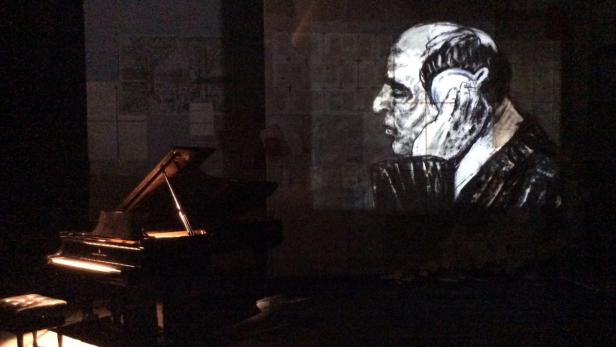"The Winterreise that was somewhere in me all these years"

Recognized as one of the world’s greatest contemporary artists, William Kentridge is also a director, stage designer and performer who has made a decisive impact in theatre and opera today. In practice, Kentridge, “homme de théâtre” functions as a Doppelgänger to Kentridge, the artist. The stage being the meeting point where the two confront each other in a collision of media involving film, sculpture, drawing, performance, music and dance.
Viennese audiences were one of the first to experience his inception in the operatic genre with "Il Retorno d’Ulisse" of Monteverdi at the Sofiensäle in 1998, an enthrallingly beautiful production where Teschner-like puppets and film interact in a feat of epic story telling. At the invitation of Karl Regensburger and the ImPulsTanz festival, Kentridge returned to Vienna last summer with a rousing multi-media production, "Refuse the Hour", starring the South African dancer Dada Masilo, garnering a resounding success.
In turn, his next opus, Schubert’s "Winterreise", a project commissioned by the pianist Markus Hinterhäuser, who also performs the cycle with baritone Matthias Goerne, will have its world premiere Monday June 9th at the Wiener Festwochen. In contrast to Refuse the Hour, this is an intimate work that probes into personal and family history. Kentridge remembers first hearing the "Winterreise" in the presence of his father, Sydney Kentridge, a famous lawyer and leading figure in the anti-apartheid movement who defended Nelson Mandela during the Treason Trial (1956-1961). On Sunday afternoon, in their Johannesburg salon, a peaceful haven in troubled times, the rich baritone voice of Dietrich Fischer-Dieskau that filled the room with German Lieder though beautiful had something disquieting: this was in the 1960s, where in my family it was still out of the question to buy a German car, or even visit Germany or Austria. Sometimes my mother would be in the room, but more often than not, she would leave. She never liked Lieder, but tolerated it for my father’s sake.
KURIER: How did your own Winterreise emerge from this historical and childhood context?
William Kentridge: The shock has been to find a "Winterreise" that was somewhere in me all these years - as if I had been drawing the project for twenty years. When I listened to those twenty-four songs, Schubert’s music and the text of Wilhelm Müller while viewing my pre-existing films, the surprise was that there is a coherence between all three. These affinities had to do with rhythm, the tone of image, and associations released by the music and the films.
How did the theme of the Romantic “Wanderer” and the wintery rural landscape relate to your Johannesburg inspired films?
The trope of walking, wandering, or procession is present in many of my works like my piece for Documenta 13, the Refusal of Time. The discovery of the Romantic landscapes of Caspar David Friedrich, in particularly the "Large Enclosure" (1832), made a strong impression on me at an early age; the thin strip of land with trees against the marsh, and an empty sky and especially the emptiness of the foreground or non-landscape. Without realizing it, this work was the reference for many of my own landscapes.
How do you evoke the cold and falling snow; symbols of solitude, and hushed emotions for both Friedrich and Schubert, but completely foreign to the South African experience.
I was relieved not to have to draw snow (it has only snowed five times in the 58 years of my life in Johannesburg). I discovered that the black paper confetti that I had used in several earlier films was already falling snow and this became the slowly descending flakes of "Gefrorne Tränen" for example.

These rehearsals were absolutely vital to the production. After the first rehearsal period, I completely changed my concept for certain songs; I went back to the editing table and I redid three songs entirely. When Matthias performs he requires very close contact with Markus to the extent that he almost seems climbs inside the piano with the lid over his head! I had to rethink the positioning of the piano on stage so that he was not engulfed by it. In the end, it is great because at times the projections emanate out of his back, or out of the piano. Matthias gives a vulnerable performance, at times enormously passionate, and then strangely quiet and fragile. It is a closed dialogue between the pianist and singer that the audience is allowed to watch from the side, rather than something that is being performed to an audience.
The pianist and the singer are two distinct characters, and through your films we encounter the Third Man, the artist. It seems that your reading of the work retraces a personal journey.
It is really fragments of a personal history that connect to a broader history; that of German Romanticism held in the memory of a song cycle, held in a Johannesburg childhood.
Kommentare